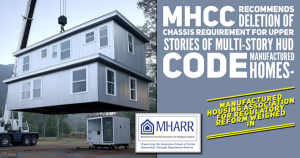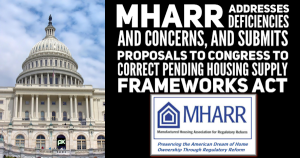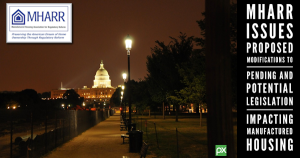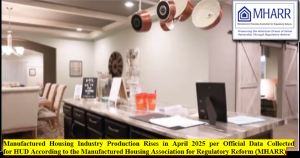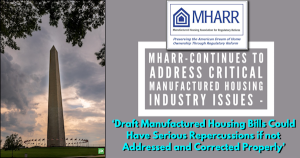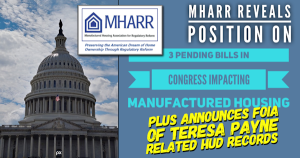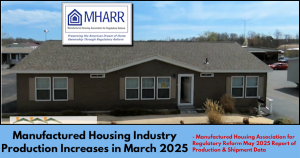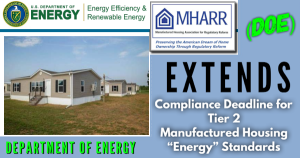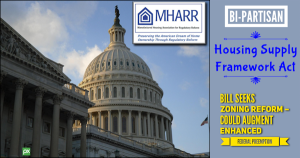“An Unequaled Opportunity About to Go to Waste”
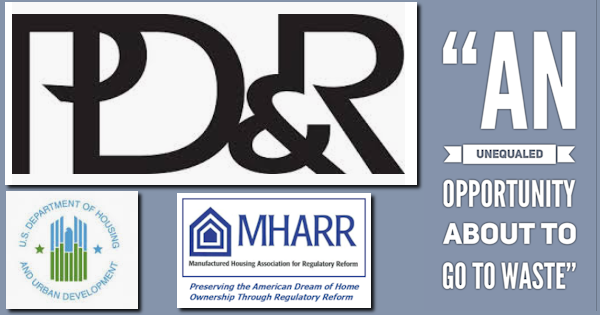
The latest issue of the quarterly publication of HUD’s Office of Policy Development and Research (PD&R) – called “Evidence Matters” — has been released to great fanfare by the Manufactured Housing Institute (MHI). Ostensibly, the fanfare arises from the fact that this “Winter/Spring” edition of “Evidence Matters” focuses on “Factory-Built Housing,” including manufactured homes. And, to be sure, PD&R, in 30-plus pages, rightfully extolls the virtues of factory-built housing in general, and HUD-regulated manufactured housing in particular, as a national affordable housing resource. Ultimately, though, the fanfare is overdone, as PD&R, instead of addressing the real issues and failures that have suppressed the industry – and its ability to provide truly affordable and much-needed housing for millions of moderate and lower-income American families – for more than a decade, simply plows the same ground that has been pored over by the same policy wonks for years, while ignoring the changes that need to be made, consistent with the regulatory reform policies of President Trump, in order to revitalize the industry.
PD&R, for example, devotes nearly half of its publication to articles concerning “energy efficiency” (a misdirected and discriminatory Obama Administration priority for manufactured housing), the benefits of factory-based construction (which are already well-documented), consumer “education” and other subjects that have already been thoroughly addressed by HUD and others over the years. Meanwhile, it gives short-shrift – exactly one paragraph – to arguably the most significant roadblock to the greater utilization and availability of affordable manufactured homes, i.e., discriminatory local zoning edicts that either exclude or severely restrict the placement of HUD-regulated manufactured homes. Even worse, and not surprisingly given its primary focus on other matters, PD&R totally ignoresthe potent statutory remedy that the law already provides HUD to deal with this issue – the enhanced federal preemption of the Manufactured Housing Improvement Act of 2000.
Ultimately, all of this is a distraction and diversion. HUD knows that exclusionary zoning is a major problem for the manufactured homes that it regulates. It also knows that it – HUD — has the statutory authority to preempt those exclusionary edicts. But it prefers (for now) to simply sidestep the problem and its extremely negative impacts.
Nor does PD&R make any real attempt to deal with the second major national issue that has needlessly suppressed the manufactured housing market and the availability of affordable manufactured homes for American consumers – the discriminatory lack of any meaningful federal support for manufactured home consumer financing. This massive long-term failure, in and of itself, has needlessly suppressed the manufactured housing market for decades, while baselessly excluding millions of otherwise qualified American families from the housing market altogether.
The two central elements of this failure are: (1) the discriminatory refusal of Fannie Mae and Freddie Mac to support the implementation of the Duty to Serve Underserved Markets (DTS) with respect to the vast bulk of the manufactured housing consumer finance market served by personal property (chattel) loans, combined with refusal of the Federal Housing Finance Agency (FHFA) to compel full compliance with DTS; and (2) the de facto elimination of the Federal Housing Administration’s (FHA) Title I manufactured housing program as a significant consumer financing resource due to the baseless “10-10” rule imposed by Ginnie Mae, which has excluded almost all potential financing participants from the program. Instead of addressing these key issues in its report in any meaningful way, worthy of their extremely negative impact, PD&R simply glides by these issues asserting, without any basis whatsoever, that FHFA “is helping to address financing challenges through the Duty to Serve program.” That’s it. Exactly one sentence regarding consumer financing – and an inaccurate and misleading sentence at that — before moving-on to a longer discussion of “tenant protections” within communities (yet another topic that has already been explored endlessly for years).
As a result, while any significant action on President Trump’s signature issues, federal regulatory reform and ensuring the availability of affordable housing for American families, continues to go nowhere at HUD’s Office of Manufactured Housing Programs (OMHP) with just months now remaining before the conclusion of the President’s current term, this swing and miss by PD&R is more evidence that HUD, with the express support of MHI and the industry’s largest corporate conglomerates — and with time running out — is focused more on “PR” (i.e., public relations) than real reform that would benefit consumers and the industry’s thousands of smaller, independent businesses. This same is also evident from HUD’s continuing and ongoing failure to include manufactured housing as a full and equal participant in all of HUD’s housing and housing finance programs. Thus, while HUD and others try to garner credit through press releases and “photo ops,” real progress – and real results – have been lacking.
Indeed, the only truly significant on-the-ground progress that has occurred within OMHP since President Trump took office in 2017, was the removal and re-assignment of former program administrator Pamela Danner, which MHARR – and only MHARR – pursued, as reported by the Washington Post. Since that time, there have been numerous announcements and pronouncements of supposedly grand initiatives at HUD. There have been “photo ops” and exhibits, displays and exhibitions – most (if not all) of which have inured to the benefit of the industry’s largest conglomerates. But precious little in the way of actual change and reform of the federal program to fully comply with all applicable federal laws – change that would benefit the vast bulk of the industry’s smaller businesses and the nation’s consumers of affordable housing now and in the long term – has occurred, meaning that three years of arguably unparalleled opportunity has already been wasted.
The industry does not need lip service from HUD, its federal regulator. While the industry and its businesses can appreciate the words of support that have emanated from HUD and from HUD Secretary Ben Carson, and the positive exposure that federally-regulated manufactured homes have received through various HUD events, what the industry and its consumers really need is action – action to fully and properly implement all remaining reforms of the Manufactured Housing Improvement Act of 2000 (including zoning preemption and an appointed non-career program administrator, among other things); action to eliminate unnecessary and unduly burdensome standards, regulations and sub-regulatory “guidance” in accordance with all of President Trump’s regulatory reform Executive Orders and policies; and the full, market-significant implementation – right now — of the DTS mandate, including support for manufactured housing personal property loans. As MHARR has pointedly observed, however, there has been no meaningful action on any of these priorities, as program regulators and revenue-driven program contractors work to simply “run out the clock” on the Trump Administration.
With industry production consistently stuck below its historic 100,000 homes-per-year benchmark for more than a decade, and with 2020 now unlikely to break this long-term trend due to a combination of industry-specific and broader socio-economic factors (including the COVID-19 pandemic and related closures), it is more urgent than ever that the industry and its consumers achieve real and, just as importantly, lasting regulatory reform, rather than just collecting empty promises, as has been the case all too often in the past. And with President Trump in office, the industry has (and has had) perhaps its best opportunity ever to bring about the kind of genuine reform within OMHP that is so badly needed in order to propel an industry renaissance and revitalization. With each day that passes, however, without specific, concrete action to implement such essential reforms, the unparalleled window of opportunity presented by the Trump Administration and its regulatory policies is closing.
Is it too late to achieve the type of change that is desperately needed? No, particularly with new leadership – in the person of Ms. Dana Wade – headed back to HUD as the top-level political appointee with direct authority over the federal manufactured housing program. But time is running out and the status quo remains unacceptable. The primaryOMHP regulatory reform process pending at HUD was put in place by Ms. Wade in early 2018. She should see to it that this crucial process is completed – and all resulting reforms are implemented – before the November 2020 presidential election. This will be a tall order administratively, but if meaningful reform of any kind is to occur within OMHP, it must be an urgent priority for Ms. Wade and for all of HUD’s senior leadership.
It is commendable then, that PD&R chose to focus on factory-built housing in its latest publication. But that cannot be and must not become a substitute for concrete action by HUD on the major issues that have suppressed industry growth for far too long.
PD&R promised – and has taken the first steps to initiate – a study of discriminatory zoning impacts on the industry and consumers of affordable housing. That study should continue without delay. Beyond that, and among other things, HUD should expressly acknowledge the authority that it has under the enhanced preemption language of the 2000 reform law to supersede zoning edicts that undermine its superintendence of the manufactured housing industry and the express purposes of the 2000 reform law, while simultaneously taking action to end financing discrimination against mainstream manufactured housing purchasers.
Put simply, the time for posturing and displays is over and the time for specific, significant action is slowly running out.
Mark Weiss
MHARR is a Washington, D.C.-based national trade association representing the views and interests of independent producers of federally-regulated manufactured housing.
“MHARR-Issues and Perspectives” is available for re-publication in full (i.e., without alteration or substantive modification) without further permission and with proper attribution to MHARR.
The latest issue of the quarterly publication of HUD’s Office of Policy Development and Research (PD&R) – called “Evidence Matters” — has been released to great fanfare by the Manufactured Housing Institute (MHI). Ostensibly, the fanfare arises from the fact that this “Winter/Spring” edition of “Evidence Matters” focuses on “Factory-Built Housing,” including manufactured homes. And, to be sure, PD&R, in 30-plus pages, rightfully extolls the virtues of factory-built housing in general, and HUD-regulated manufactured housing in particular, as a national affordable housing resource. Ultimately, though, the fanfare is overdone, as PD&R, instead of addressing the real issues and failures that have suppressed the industry – and its ability to provide truly affordable and much-needed housing for millions of moderate and lower-income American families – for more than a decade, simply plows the same ground that has been pored over by the same policy wonks for years, while ignoring the changes that need to be made, consistent with the regulatory reform policies of President Trump, in order to revitalize the industry.
PD&R, for example, devotes nearly half of its publication to articles concerning “energy efficiency” (a misdirected and discriminatory Obama Administration priority for manufactured housing), the benefits of factory-based construction (which are already well-documented), consumer “education” and other subjects that have already been thoroughly addressed by HUD and others over the years. Meanwhile, it gives short-shrift – exactly one paragraph – to arguably the most significant roadblock to the greater utilization and availability of affordable manufactured homes, i.e., discriminatory local zoning edicts that either exclude or severely restrict the placement of HUD-regulated manufactured homes. Even worse, and not surprisingly given its primary focus on other matters, PD&R totally ignoresthe potent statutory remedy that the law already provides HUD to deal with this issue – the enhanced federal preemption of the Manufactured Housing Improvement Act of 2000.
Ultimately, all of this is a distraction and diversion. HUD knows that exclusionary zoning is a major problem for the manufactured homes that it regulates. It also knows that it – HUD — has the statutory authority to preempt those exclusionary edicts. But it prefers (for now) to simply sidestep the problem and its extremely negative impacts.
Nor does PD&R make any real attempt to deal with the second major national issue that has needlessly suppressed the manufactured housing market and the availability of affordable manufactured homes for American consumers – the discriminatory lack of any meaningful federal support for manufactured home consumer financing. This massive long-term failure, in and of itself, has needlessly suppressed the manufactured housing market for decades, while baselessly excluding millions of otherwise qualified American families from the housing market altogether.
The two central elements of this failure are: (1) the discriminatory refusal of Fannie Mae and Freddie Mac to support the implementation of the Duty to Serve Underserved Markets (DTS) with respect to the vast bulk of the manufactured housing consumer finance market served by personal property (chattel) loans, combined with refusal of the Federal Housing Finance Agency (FHFA) to compel full compliance with DTS; and (2) the de facto elimination of the Federal Housing Administration’s (FHA) Title I manufactured housing program as a significant consumer financing resource due to the baseless “10-10” rule imposed by Ginnie Mae, which has excluded almost all potential financing participants from the program. Instead of addressing these key issues in its report in any meaningful way, worthy of their extremely negative impact, PD&R simply glides by these issues asserting, without any basis whatsoever, that FHFA “is helping to address financing challenges through the Duty to Serve program.” That’s it. Exactly one sentence regarding consumer financing – and an inaccurate and misleading sentence at that — before moving-on to a longer discussion of “tenant protections” within communities (yet another topic that has already been explored endlessly for years).
As a result, while any significant action on President Trump’s signature issues, federal regulatory reform and ensuring the availability of affordable housing for American families, continues to go nowhere at HUD’s Office of Manufactured Housing Programs (OMHP) with just months now remaining before the conclusion of the President’s current term, this swing and miss by PD&R is more evidence that HUD, with the express support of MHI and the industry’s largest corporate conglomerates — and with time running out — is focused more on “PR” (i.e., public relations) than real reform that would benefit consumers and the industry’s thousands of smaller, independent businesses. This same is also evident from HUD’s continuing and ongoing failure to include manufactured housing as a full and equal participant in all of HUD’s housing and housing finance programs. Thus, while HUD and others try to garner credit through press releases and “photo ops,” real progress – and real results – have been lacking.
Indeed, the only truly significant on-the-ground progress that has occurred within OMHP since President Trump took office in 2017, was the removal and re-assignment of former program administrator Pamela Danner, which MHARR – and only MHARR – pursued, as reported by the Washington Post. Since that time, there have been numerous announcements and pronouncements of supposedly grand initiatives at HUD. There have been “photo ops” and exhibits, displays and exhibitions – most (if not all) of which have inured to the benefit of the industry’s largest conglomerates. But precious little in the way of actual change and reform of the federal program to fully comply with all applicable federal laws – change that would benefit the vast bulk of the industry’s smaller businesses and the nation’s consumers of affordable housing now and in the long term – has occurred, meaning that three years of arguably unparalleled opportunity has already been wasted.
The industry does not need lip service from HUD, its federal regulator. While the industry and its businesses can appreciate the words of support that have emanated from HUD and from HUD Secretary Ben Carson, and the positive exposure that federally-regulated manufactured homes have received through various HUD events, what the industry and its consumers really need is action – action to fully and properly implement all remaining reforms of the Manufactured Housing Improvement Act of 2000 (including zoning preemption and an appointed non-career program administrator, among other things); action to eliminate unnecessary and unduly burdensome standards, regulations and sub-regulatory “guidance” in accordance with all of President Trump’s regulatory reform Executive Orders and policies; and the full, market-significant implementation – right now — of the DTS mandate, including support for manufactured housing personal property loans. As MHARR has pointedly observed, however, there has been no meaningful action on any of these priorities, as program regulators and revenue-driven program contractors work to simply “run out the clock” on the Trump Administration.
With industry production consistently stuck below its historic 100,000 homes-per-year benchmark for more than a decade, and with 2020 now unlikely to break this long-term trend due to a combination of industry-specific and broader socio-economic factors (including the COVID-19 pandemic and related closures), it is more urgent than ever that the industry and its consumers achieve real and, just as importantly, lasting regulatory reform, rather than just collecting empty promises, as has been the case all too often in the past. And with President Trump in office, the industry has (and has had) perhaps its best opportunity ever to bring about the kind of genuine reform within OMHP that is so badly needed in order to propel an industry renaissance and revitalization. With each day that passes, however, without specific, concrete action to implement such essential reforms, the unparalleled window of opportunity presented by the Trump Administration and its regulatory policies is closing.
Is it too late to achieve the type of change that is desperately needed? No, particularly with new leadership – in the person of Ms. Dana Wade – headed back to HUD as the top-level political appointee with direct authority over the federal manufactured housing program. But time is running out and the status quo remains unacceptable. The primaryOMHP regulatory reform process pending at HUD was put in place by Ms. Wade in early 2018. She should see to it that this crucial process is completed – and all resulting reforms are implemented – before the November 2020 presidential election. This will be a tall order administratively, but if meaningful reform of any kind is to occur within OMHP, it must be an urgent priority for Ms. Wade and for all of HUD’s senior leadership.
It is commendable then, that PD&R chose to focus on factory-built housing in its latest publication. But that cannot be and must not become a substitute for concrete action by HUD on the major issues that have suppressed industry growth for far too long.
PD&R promised – and has taken the first steps to initiate – a study of discriminatory zoning impacts on the industry and consumers of affordable housing. That study should continue without delay. Beyond that, and among other things, HUD should expressly acknowledge the authority that it has under the enhanced preemption language of the 2000 reform law to supersede zoning edicts that undermine its superintendence of the manufactured housing industry and the express purposes of the 2000 reform law, while simultaneously taking action to end financing discrimination against mainstream manufactured housing purchasers.
Put simply, the time for posturing and displays is over and the time for specific, significant action is slowly running out.
Mark Weiss
MHARR is a Washington, D.C.-based national trade association representing the views and interests of independent producers of federally-regulated manufactured housing.
“MHARR-Issues and Perspectives” is available for re-publication in full (i.e., without alteration or substantive modification) without further permission and with proper attribution to MHARR.



